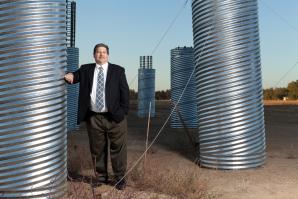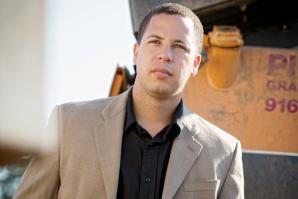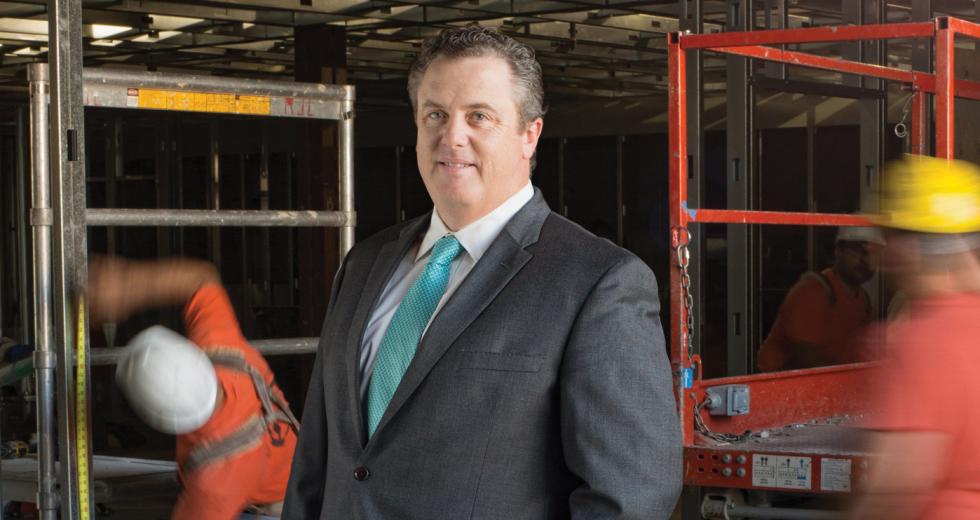James Fitzgerald, 45, became a partner and vice president of Market One Builders Inc. in 1999. The Sacramento-based firm has a well-established reputation as a Northern California leader in the construction of complex, sustainable projects, including mission-critical facilities, landmark urban renovations and commercial office environments. Fitzgerald currently serves as chairman of Associated Builders and Contractors of Northern California and is a member of the Region Builders board of directors.
“Sustainability is an interesting word. Most people link it to green, eco-friendly, LEED-certified projects. For us, it’s building something that can last the test of time. It’s building relationships and making good decisions.”
“Give the client what he wants and nothing more. It’s not about going the extra mile. We don’t come in and say lets overbuild this, give them something we have done on other projects. For us, it starts by being good listeners. Figure out what they want, and then intuitively design and build out a space that is perfect for them.”
“From our sustainability point of view, there are two extremes. On the left, you have a gal in a tree. On the right, you have the guy plowing up prime farmland and paving over the Central Valley. Well there is a huge gap between the two views. Our thing is to not always go to the extreme left and spend an extra $500,000 just to make the ultimate green building. What the owner wants is the key, not up-selling by us.”
“During the good years, it’s critical to build and maintain good relationships. During the five-year recession, it was those relationships that enabled us to remain profitable. While we still had to be competitive, even with the bid projects, we continued to negotiate what we could. We were all swimming in the same pool. Everybody was trying to craft a special division to compete for and appeal to clients.”
“We have followed a couple of our Sacramento clients to the Bay Area. Business is picking up a little quicker down there. We tried to manage the relationships and the Bay Area work from here, but it was just getting too difficult to service client needs correctly. So we opened an office in Walnut Creek and hired an office manager.”
“Business is done a bit differently in the Bay Area. It’s not a bid/build mentality like you find in Sacramento. The whole contracting process there is all about guaranteed maximum price. It is a contract method where a lot of people and separate companies work together as a team. It’s very transparent. The owners see all the numbers across the board. Contractor fees have already been negotiated. Everybody knows what they are making. It’s just a matter of getting it done now.”
“For us, bidding a project is very expensive. If you don’t have to do that, you can be much more aggressive on the pricing for the owner. It’s a mentality of providing value. When you have a dozen or so different bids from architects, contractors, engineers, vendors, it becomes a relay race. Every time you pass the baton there’s a chance something gets dropped. And when that happens, it goes back to the owner in the form of a change order.”
“Design, bid, bill is predominantly what public work projects are. We jokingly call them design, bid, bill, sue because that is often what happens with these projects. But I’ll tell you that there are companies that rely on change orders as part of their business model. But it is not our model. If we have a change order on one of our privately negotiated projects, it’s an embarrassment. Quite frankly, the contract doesn’t allow for it.”
“For us, sustainable relationships are key to our long-term success. We’re not just going to do a project for you. We’re going to do a great project so that in the future we will do multiple projects together. We’re in the private sector, so we are able to do that. In the public sector, that relationship building is not as important because the next project is going right back out to bid, and the lowest bid is going to win.”
“Building-information modeling is the buzz word in the industry today. It’s computer-generated information that not only allows you to see the front of the building, but now you can virtually walk through the front door, see the walls, the light fixtures, the stairs. You can go upstairs and downstairs and out back and see everything holistically at one time. With this knowledge, the entire team together can tweak the model so that all changes and improvements get taken care of long before ground is broken.”
“For us, it’s a tool. It’s not the end all, be all. At the end of the day, I have to still be working with the electricians in the field and the guys that are digging the ditches, stringing the conduits and working with switchgears. That piece has not changed. It’s getting there that has changed.”
“As a general contractor, we like to control the [subcontractors]. That’s our contractual hammer. We want subcontractors obligated to us. Because if we say, ‘Mr. Owner this is going to cost you $15 million over 14 months,’ we want to have the confidence that we can meet that obligation. To have that confidence, we like to control the whole thing.”
“We’re now involved in building assessment, especially in the downtown Sacramento market. This gets us involved even earlier in the process. As a general contractor, we are now assessing existing buildings in downtown for our clients. It may be a historic registered building. It likely needs seismic work and electrical upgrades. So we will go in and review structural and life-safety issues, the exiting and the stairs, the roof and the [heating, ventilating and air conditioning]. Ultimately, we figure what their commitment to the building is going to be financially and determine if it makes sense for them.”
“Not sure if it’s the chicken-or-egg thing when it comes to downtown development. Right now, everyone is simply being cautious. You talk to any real estate developer, and they will tell you they remain bullish on the Sacramento area, but not yet bullish on the entire downtown area. Everyone is still waiting to see what happens first. But when you see one shovel put in the ground for that arena, you will see a flurry of activity. There is some quiet, behind-the-scene speculation going on by those that want to position themselves for what might happen.”
“Someone once told me that volunteering is what retired people do. I don’t prescribe to that type of mentality. Our mission statement is to do the right thing. You can choose not to engage with community needs, but to me that is not doing the right thing. My mother raised me with the mentality that other people need you more than you need yourself. I still believe in that and live that.”
Recommended For You

Love Thy Neighbor
Sacramentans love infill development – until it actually happens
Infill development is promoted as an antidote to suburban sprawl and environmental degradation and is championed by city planners, environmentalists and policy makers of all persuasions. But as local developers Paul Petrovich and Phil Angelides have long known, infill leads to fights over allegations of increased traffic or environmental hazards.

Region Builder
Acuity with Joshua Wood
Joshua Wood, 31, is the executive director of Region Builders, a commercial-building trade association and coalition. Region Builders is comprised of 13 industry and professional associations representing architects, engineers, contractors, developers and allied firms from the Sacramento area.



